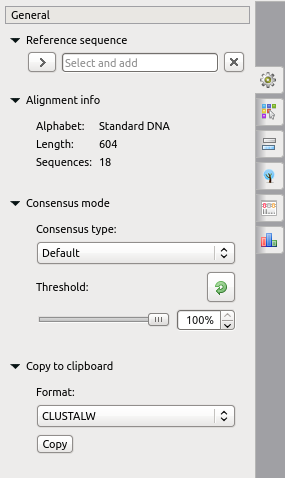Each base of a consensus sequence is calculated as a function of the corresponding column bases. There are different methods to calculate the consensus. Each method reveals unique biological properties of the aligned sequences. The Alignment Editor allows switching between different consensus modes. To switch the consensus mode go to the General tab of the Options Panel or activate the context menu (using the right mouse button) or the Actions menu and select the Consensus mode item and General tab will be opened automatically:

There are several consensus modes:
- JalView (Default) — the mode is based on the JalView algorithm. A character in the consensus is calculated based on the characters in the corresponding column and the value of the threshold:
- If the percentage value of a character is greater than the threshold, the character is shown in upper case in the consensus.
- If there are two characters with high frequency in a column, the '+" sign is shown.
- If the percentage value of a character is high, but lower than the specified threshold, the character is shown in lower case in the consensus.
- ClustalW — emulates the ClustalW program behavior.
- Levitsky — proposed by Victor Levitsky, this mode calculates the consensus of a DNA alignment, taking into account frequencies of characters in the whole alignment, i.e. not only one column. The algorithm includes these steps:
- Collect global alignment frequencies for every character using the extended DNA alphabet.
- For every column select the rarest character in the whole alignment with the percentage in the column greater or equal to the threshold value.
- Simple extended — a character of the consensus is calculated based on the characters in the corresponding column. The extended DNA alphabet is used for the result consensus, the threshold value is also taken into account.
- Strict — if a character percentage in a column is higher than the specified threshold, the character is shown in the consensus at this position. Otherwise, a gap character (‘—’) is shown.
Also the General tab shows the general information about an alignment and allows one to set up a reference sequence. The following chapter describes how to export a consensus sequence: